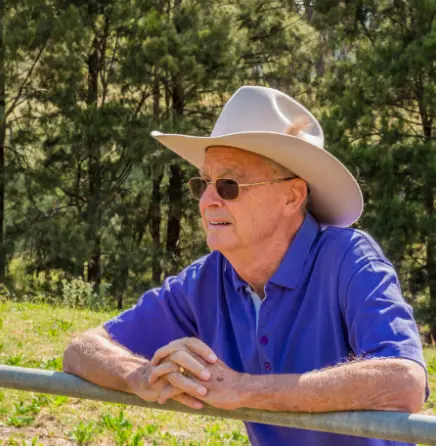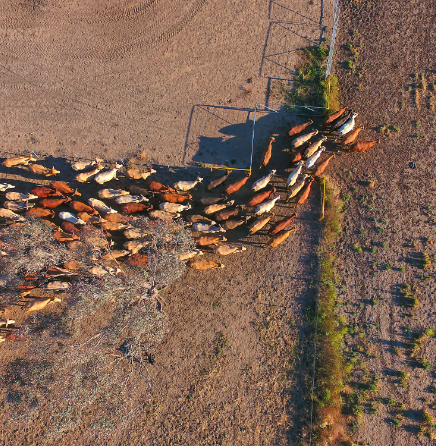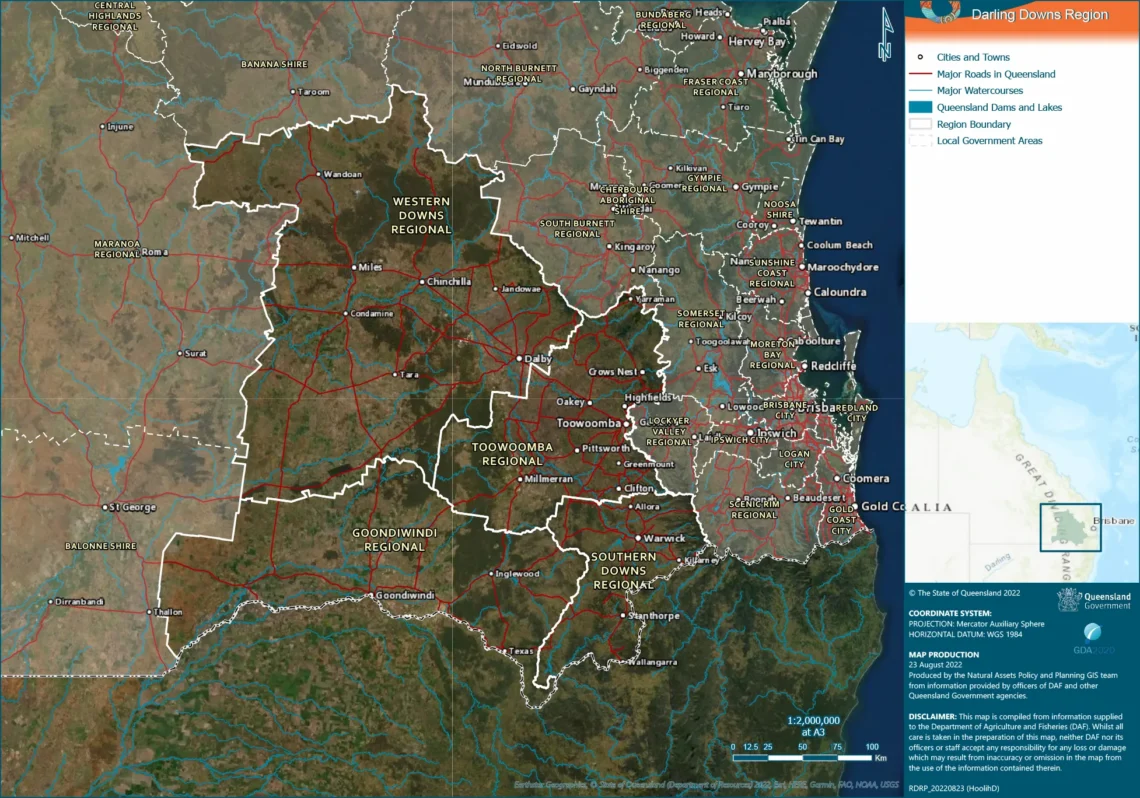

Overview of Darling Downs
What we now call ‘The Darling Downs’ was the traditional home to the First Nations people of the Keinjan, Giabal, Bigambul, Jarowair and Barunggam tribes – a subset of the Wakka Wakka language speakers. This land has always been fertile, and its bounties were enjoyed by First Nations owners even before the arrival of Europeans.
These days, the Darling Downs regional economies are still heavily reliant on agriculture. Due to the large array of crops (extensive and intensive) grown in the region, at any time of the year there is a crop in the ground which requires rain.
The Darling Downs region comprises of the following LGAs: Goondiwindi Regional Council; Southern Downs Regional Council; Toowoomba Regional Council; Western Downs Regional Council. Significant population centres and Towns include Toowoomba, Goondiwindi, Stanthorpe, Warwick, Dalby, Moonie, Chinchilla, Esk and Kilcoy.
Past impacts of drought in this region
Past impacts | People, culture and community
EXTRACTS FROM THE FULL RDRP PLAN

- All LGAs experienced population growth below the average for regional Queensland.
- People leave the region during drought which leaves a variety of adverse flow-on effects and the region’s population is rapidly ageing.
- Drought exacerbates chronic stresses and underlying issues.
Past impacts | Economy

Many farms and properties have been forced to decrease their reliance on a single source of agricultural income through the diversification of income streams. This is being achieved through seeking off-farm income as well as introducing a wider range of agricultural activities on farm.
Past impacts | Landscape and natural environment
EXTRACTS FROM THE FULL RDRP PLAN

The impacts of the most recent prolonged droughts are driving ‘on-farm’ land management practice change. The ABARES Natural Resource Management and Drought Resilience survey (2021) measured the uptake extent of 20 progressive land management related practices on 478 Queensland farms and properties.
The drought preparation practices with the highest uptake were:
- de-stocking early in low rainfall periods to preserve groundcover (68% of farms)
- improving soil water retention (64% of farms)
- increasing fodder and grain storage (58% of farms).
Past impacts | Infrastructure and built environment
EXTRACTS FROM THE FULL RDRP PLAN

Infrastructure takes many forms including physical infrastructure such as roads, rail lines, water storages/ structures, buildings, weather stations and communication towers and other utility services infrastructure and non-physical infrastructure such as that to allow digital connectivity.
For most infrastructure, the most significant impacts of drought come from:
- increasing lack of funds for infrastructure investment and/or maintenance;
- decrease in available (or able) personnel to carry out construction and/or maintenance.
“Inland rail will be one of the biggest, if not the biggest contributors to building drought resilience in the region.”
Community Member
Past impacts | People, culture and community
EXTRACTS FROM THE FULL RDRP PLAN

- All LGAs experienced population growth below the average for regional Queensland.
- People leave the region during drought which leaves a variety of adverse flow-on effects and the region’s population is rapidly ageing.
- Drought exacerbates chronic stresses and underlying issues.
Past impacts | Economy

Many farms and properties have been forced to decrease their reliance on a single source of agricultural income through the diversification of income streams. This is being achieved through seeking off-farm income as well as introducing a wider range of agricultural activities on farm.
Past impacts | Landscape and natural environment
EXTRACTS FROM THE FULL RDRP PLAN

The impacts of the most recent prolonged droughts are driving ‘on-farm’ land management practice change. The ABARES Natural Resource Management and Drought Resilience survey (2021) measured the uptake extent of 20 progressive land management related practices on 478 Queensland farms and properties.
The drought preparation practices with the highest uptake were:
- de-stocking early in low rainfall periods to preserve groundcover (68% of farms)
- improving soil water retention (64% of farms)
- increasing fodder and grain storage (58% of farms).
Past impacts | Infrastructure and built environment
EXTRACTS FROM THE FULL RDRP PLAN

Infrastructure takes many forms including physical infrastructure such as roads, rail lines, water storages/ structures, buildings, weather stations and communication towers and other utility services infrastructure and non-physical infrastructure such as that to allow digital connectivity.
For most infrastructure, the most significant impacts of drought come from:
- increasing lack of funds for infrastructure investment and/or maintenance;
- decrease in available (or able) personnel to carry out construction and/or maintenance.
“Inland rail will be one of the biggest, if not the biggest contributors to building drought resilience in the region.”
Community Member
Likely future impacts of drought in this region
Future impacts | People, culture and community

Regional population will only increase minimally – mostly in Toowoomba

Increase in ageing – both ‘on-farm’ and in regional centres and towns/villages

Increased heatwave occurences
Future impacts | Economy

‘Increase in livestock, fish stock, and crop losses as a result of the exacerbation of drought conditions may result in significant consequences for already strained business owners and communities.’

‘Substantial impacts to the agricultural community and wider sector are almost certain due to the impact of sustained elevated temperatures on crops, livestock, and the exacerbation of pre-existing drought conditions and underlying bushfire risk.’

‘Where the heatwave leads to extended periods of disruption and greater impacts to infrastructure, recovery costs for damage to infrastructure and non-supply periods are likely to be high.’
Future impacts | Landscape and natural environment

- More hot days and warm spells are projected with very high confidence.
- Average winter rainfall is projected to decrease with high confidence.
- Increased intensity of extreme rainfall events is projected, with high confidence.
- A harsher fire-weather climate in the future (high confidence).
Future impacts | Infrastructure and built environment

‘If continued investments are not made to maintain current water infrastructure, this could pose water security issues for the region and decrease the region’s liveability, as well as affect agricultural capacity.’
Source: Queensland State Heatwave Risk Assessment (2021).
“Unless our road infrastructure improves, we won’t be able to increase the number of feedlots and size of existing feedlots in this area.”
Future impacts | People, culture and community

Regional population will only increase minimally – mostly in Toowoomba

Increase in ageing – both ‘on-farm’ and in regional centres and towns/villages

Increased heatwave occurences
Future impacts | Economy

‘Increase in livestock, fish stock, and crop losses as a result of the exacerbation of drought conditions may result in significant consequences for already strained business owners and communities.’

‘Substantial impacts to the agricultural community and wider sector are almost certain due to the impact of sustained elevated temperatures on crops, livestock, and the exacerbation of pre-existing drought conditions and underlying bushfire risk.’

‘Where the heatwave leads to extended periods of disruption and greater impacts to infrastructure, recovery costs for damage to infrastructure and non-supply periods are likely to be high.’
Future impacts | Landscape and natural environment

- More hot days and warm spells are projected with very high confidence.
- Average winter rainfall is projected to decrease with high confidence.
- Increased intensity of extreme rainfall events is projected, with high confidence.
- A harsher fire-weather climate in the future (high confidence).
Future impacts | Infrastructure and built environment

‘If continued investments are not made to maintain current water infrastructure, this could pose water security issues for the region and decrease the region’s liveability, as well as affect agricultural capacity.’
Source: Queensland State Heatwave Risk Assessment (2021).
“Unless our road infrastructure improves, we won’t be able to increase the number of feedlots and size of existing feedlots in this area.”
Regional strategy
Regional strategy | People, culture and community

Planning and monitoring
Projected outcome: A regional drought surveillance program in place that monitors and analyses key indicators of current and emerging environmental (meteorological and landscape), social and economic conditions, which are markers of drought.

Respond to drought events
Projected outcome: A drought risk and vulnerability assessment framework is updated annually to identify and rate the anticipated exposure and sensitivity to harm of the region’s communities generally and recognised more vulnerable demographic groups specifically.

Build future resilience
Projected outcome: There is widely shared and well-informed regional engagement with managing drought risk for long-term community resilience.
United drought resilience
Projected outcome: The region comes together to build drought resilience.
Regional strategy | Economy

Planning and monitoring
Projected outcome: A regional drought surveillance program is implemented that monitors and analyses key indicators of current and emerging environmental (meteorological and landscape), social and economic conditions, which are markers of drought.

Respond to drought events
Projected outcome: A drought risk and vulnerability assessment framework is annually updated to identify and rate the anticipated exposure and sensitivity to harm of the region’s economy generally and recognised more vulnerable enterprise types, supply chains and financial arrangements specifically.

Build future resilience
Projected outcome: A widespread enterprise level drought risk management is established across the region.
Regional strategy | Landscape and natural environment

Planning and monitoring
Projected outcome: A regional drought surveillance program is implemented that monitors and analyses key indicators of current and emerging environmental (meteorological and landscape), social and economic conditions, which are markers of drought.

Respond to drought events
Projected outcome: A drought risk and vulnerability assessment framework that is updated each 5 years to identify and rate the anticipated exposure and sensitivity to harm of the region’s landscapes generally and recognised more vulnerable waters, lands and ecosystems specifically.

Build future resilience
Projected outcome: Implement measures to limit impacts of drought and better respond to drought.
Regional strategy | Infrastructure and built environment

Planning and monitoring
Projected outcome: A regional drought surveillance program in place that monitors and analyses key indicators of current and emerging environmental (meteorological and landscape), social and economic conditions, which are markers of drought.

Respond to drought events
Projected outcome: A drought risk and vulnerability assessment framework is updated each 10 years to identify and rate the anticipated exposure and sensitivity to harm of the region’s built infrastructure.

Build future resilience
Projected outcome: Adequate and appropriate drought risk management for essential infrastructure is in place and stress tested for times of drought.
Regional strategy | People, culture and community

Planning and monitoring
Projected outcome: A regional drought surveillance program in place that monitors and analyses key indicators of current and emerging environmental (meteorological and landscape), social and economic conditions, which are markers of drought.

Respond to drought events
Projected outcome: A drought risk and vulnerability assessment framework is updated annually to identify and rate the anticipated exposure and sensitivity to harm of the region’s communities generally and recognised more vulnerable demographic groups specifically.

Build future resilience
Projected outcome: There is widely shared and well-informed regional engagement with managing drought risk for long-term community resilience.
United drought resilience
Projected outcome: The region comes together to build drought resilience.
Regional strategy | Economy

Planning and monitoring
Projected outcome: A regional drought surveillance program is implemented that monitors and analyses key indicators of current and emerging environmental (meteorological and landscape), social and economic conditions, which are markers of drought.

Respond to drought events
Projected outcome: A drought risk and vulnerability assessment framework is annually updated to identify and rate the anticipated exposure and sensitivity to harm of the region’s economy generally and recognised more vulnerable enterprise types, supply chains and financial arrangements specifically.

Build future resilience
Projected outcome: A widespread enterprise level drought risk management is established across the region.
Regional strategy | Landscape and natural environment

Planning and monitoring
Projected outcome: A regional drought surveillance program is implemented that monitors and analyses key indicators of current and emerging environmental (meteorological and landscape), social and economic conditions, which are markers of drought.

Respond to drought events
Projected outcome: A drought risk and vulnerability assessment framework that is updated each 5 years to identify and rate the anticipated exposure and sensitivity to harm of the region’s landscapes generally and recognised more vulnerable waters, lands and ecosystems specifically.

Build future resilience
Projected outcome: Implement measures to limit impacts of drought and better respond to drought.
Regional strategy | Infrastructure and built environment

Planning and monitoring
Projected outcome: A regional drought surveillance program in place that monitors and analyses key indicators of current and emerging environmental (meteorological and landscape), social and economic conditions, which are markers of drought.

Respond to drought events
Projected outcome: A drought risk and vulnerability assessment framework is updated each 10 years to identify and rate the anticipated exposure and sensitivity to harm of the region’s built infrastructure.

Build future resilience
Projected outcome: Adequate and appropriate drought risk management for essential infrastructure is in place and stress tested for times of drought.

